Corporate Strategy Analysis: GlaxoSmithKline and Pfizer Joint Venture
VerifiedAdded on 2021/02/19
|15
|4206
|31
Report
AI Summary
This report provides a comprehensive analysis of GlaxoSmithKline (GSK)'s corporate strategy, particularly in the context of its joint venture with Pfizer. The report begins with an introduction to corporate strategy and its importance for GSK. It then delves into an external analysis of the UK pharmaceutical industry using PESTLE and Porter's Five Forces frameworks, assessing political, economic, social, technological, legal, and environmental factors, along with competitive forces. An internal analysis follows, examining GSK's resources, value chain, and core competencies through VRIO analysis. The report evaluates the joint venture strategy using the SAF criteria, leading to a conclusion summarizing the key findings. Overall, this report offers a detailed examination of GSK's strategic positioning and decision-making within the pharmaceutical industry.
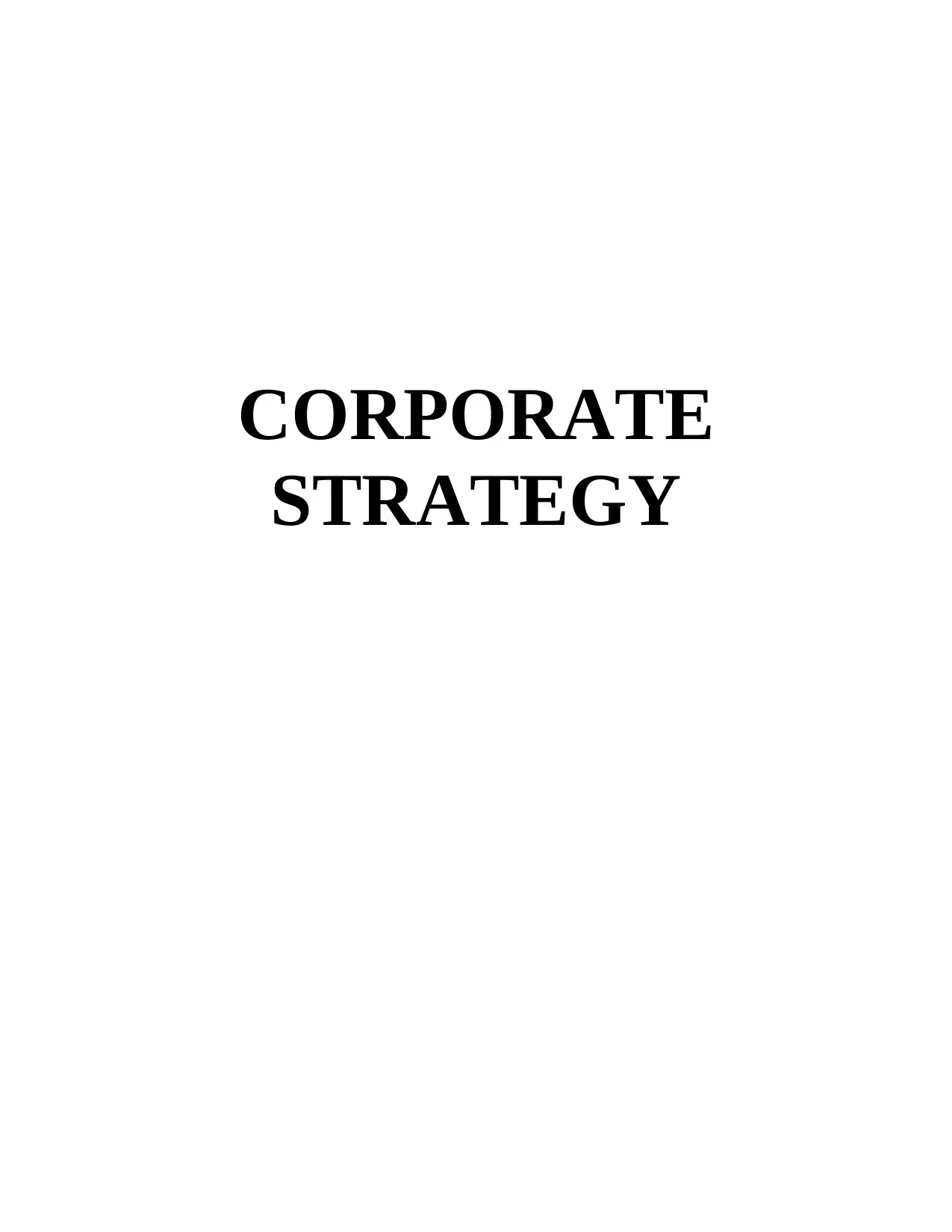
CORPORATE
STRATEGY
STRATEGY
Paraphrase This Document
Need a fresh take? Get an instant paraphrase of this document with our AI Paraphraser
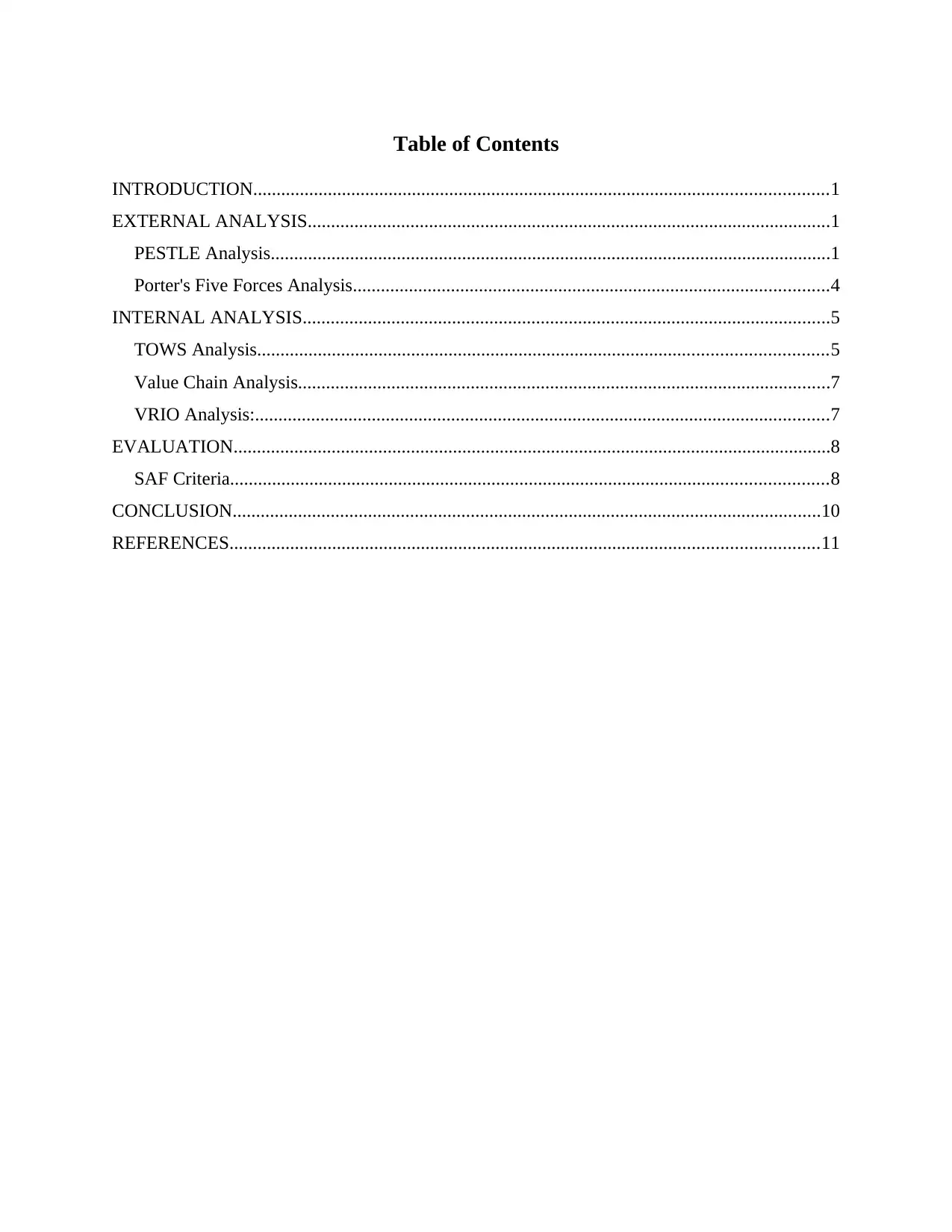
Table of Contents
INTRODUCTION...........................................................................................................................1
EXTERNAL ANALYSIS................................................................................................................1
PESTLE Analysis........................................................................................................................1
Porter's Five Forces Analysis......................................................................................................4
INTERNAL ANALYSIS.................................................................................................................5
TOWS Analysis..........................................................................................................................5
Value Chain Analysis..................................................................................................................7
VRIO Analysis:...........................................................................................................................7
EVALUATION................................................................................................................................8
SAF Criteria................................................................................................................................8
CONCLUSION..............................................................................................................................10
REFERENCES..............................................................................................................................11
INTRODUCTION...........................................................................................................................1
EXTERNAL ANALYSIS................................................................................................................1
PESTLE Analysis........................................................................................................................1
Porter's Five Forces Analysis......................................................................................................4
INTERNAL ANALYSIS.................................................................................................................5
TOWS Analysis..........................................................................................................................5
Value Chain Analysis..................................................................................................................7
VRIO Analysis:...........................................................................................................................7
EVALUATION................................................................................................................................8
SAF Criteria................................................................................................................................8
CONCLUSION..............................................................................................................................10
REFERENCES..............................................................................................................................11
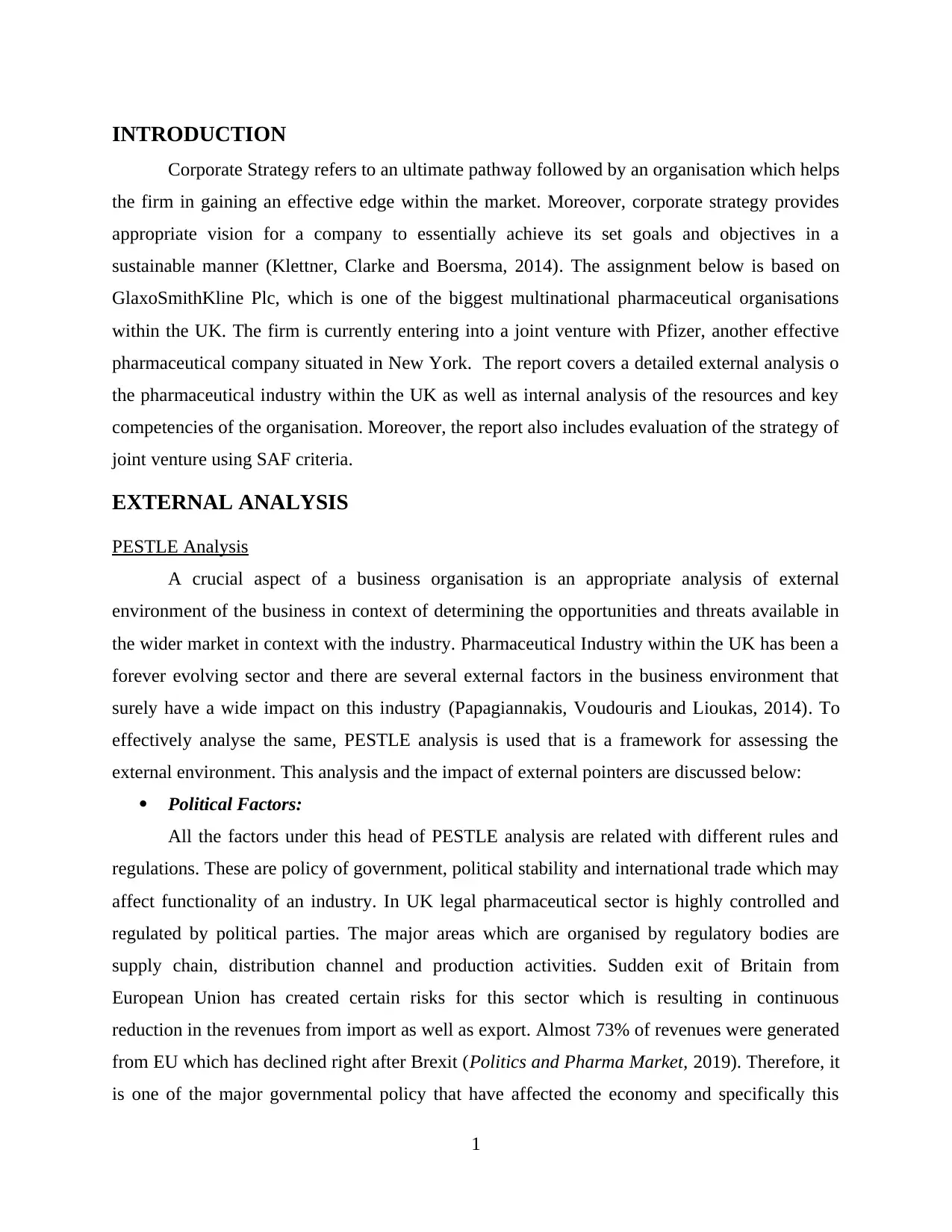
INTRODUCTION
Corporate Strategy refers to an ultimate pathway followed by an organisation which helps
the firm in gaining an effective edge within the market. Moreover, corporate strategy provides
appropriate vision for a company to essentially achieve its set goals and objectives in a
sustainable manner (Klettner, Clarke and Boersma, 2014). The assignment below is based on
GlaxoSmithKline Plc, which is one of the biggest multinational pharmaceutical organisations
within the UK. The firm is currently entering into a joint venture with Pfizer, another effective
pharmaceutical company situated in New York. The report covers a detailed external analysis o
the pharmaceutical industry within the UK as well as internal analysis of the resources and key
competencies of the organisation. Moreover, the report also includes evaluation of the strategy of
joint venture using SAF criteria.
EXTERNAL ANALYSIS
PESTLE Analysis
A crucial aspect of a business organisation is an appropriate analysis of external
environment of the business in context of determining the opportunities and threats available in
the wider market in context with the industry. Pharmaceutical Industry within the UK has been a
forever evolving sector and there are several external factors in the business environment that
surely have a wide impact on this industry (Papagiannakis, Voudouris and Lioukas, 2014). To
effectively analyse the same, PESTLE analysis is used that is a framework for assessing the
external environment. This analysis and the impact of external pointers are discussed below:
Political Factors:
All the factors under this head of PESTLE analysis are related with different rules and
regulations. These are policy of government, political stability and international trade which may
affect functionality of an industry. In UK legal pharmaceutical sector is highly controlled and
regulated by political parties. The major areas which are organised by regulatory bodies are
supply chain, distribution channel and production activities. Sudden exit of Britain from
European Union has created certain risks for this sector which is resulting in continuous
reduction in the revenues from import as well as export. Almost 73% of revenues were generated
from EU which has declined right after Brexit (Politics and Pharma Market, 2019). Therefore, it
is one of the major governmental policy that have affected the economy and specifically this
1
Corporate Strategy refers to an ultimate pathway followed by an organisation which helps
the firm in gaining an effective edge within the market. Moreover, corporate strategy provides
appropriate vision for a company to essentially achieve its set goals and objectives in a
sustainable manner (Klettner, Clarke and Boersma, 2014). The assignment below is based on
GlaxoSmithKline Plc, which is one of the biggest multinational pharmaceutical organisations
within the UK. The firm is currently entering into a joint venture with Pfizer, another effective
pharmaceutical company situated in New York. The report covers a detailed external analysis o
the pharmaceutical industry within the UK as well as internal analysis of the resources and key
competencies of the organisation. Moreover, the report also includes evaluation of the strategy of
joint venture using SAF criteria.
EXTERNAL ANALYSIS
PESTLE Analysis
A crucial aspect of a business organisation is an appropriate analysis of external
environment of the business in context of determining the opportunities and threats available in
the wider market in context with the industry. Pharmaceutical Industry within the UK has been a
forever evolving sector and there are several external factors in the business environment that
surely have a wide impact on this industry (Papagiannakis, Voudouris and Lioukas, 2014). To
effectively analyse the same, PESTLE analysis is used that is a framework for assessing the
external environment. This analysis and the impact of external pointers are discussed below:
Political Factors:
All the factors under this head of PESTLE analysis are related with different rules and
regulations. These are policy of government, political stability and international trade which may
affect functionality of an industry. In UK legal pharmaceutical sector is highly controlled and
regulated by political parties. The major areas which are organised by regulatory bodies are
supply chain, distribution channel and production activities. Sudden exit of Britain from
European Union has created certain risks for this sector which is resulting in continuous
reduction in the revenues from import as well as export. Almost 73% of revenues were generated
from EU which has declined right after Brexit (Politics and Pharma Market, 2019). Therefore, it
is one of the major governmental policy that have affected the economy and specifically this
1
⊘ This is a preview!⊘
Do you want full access?
Subscribe today to unlock all pages.

Trusted by 1+ million students worldwide
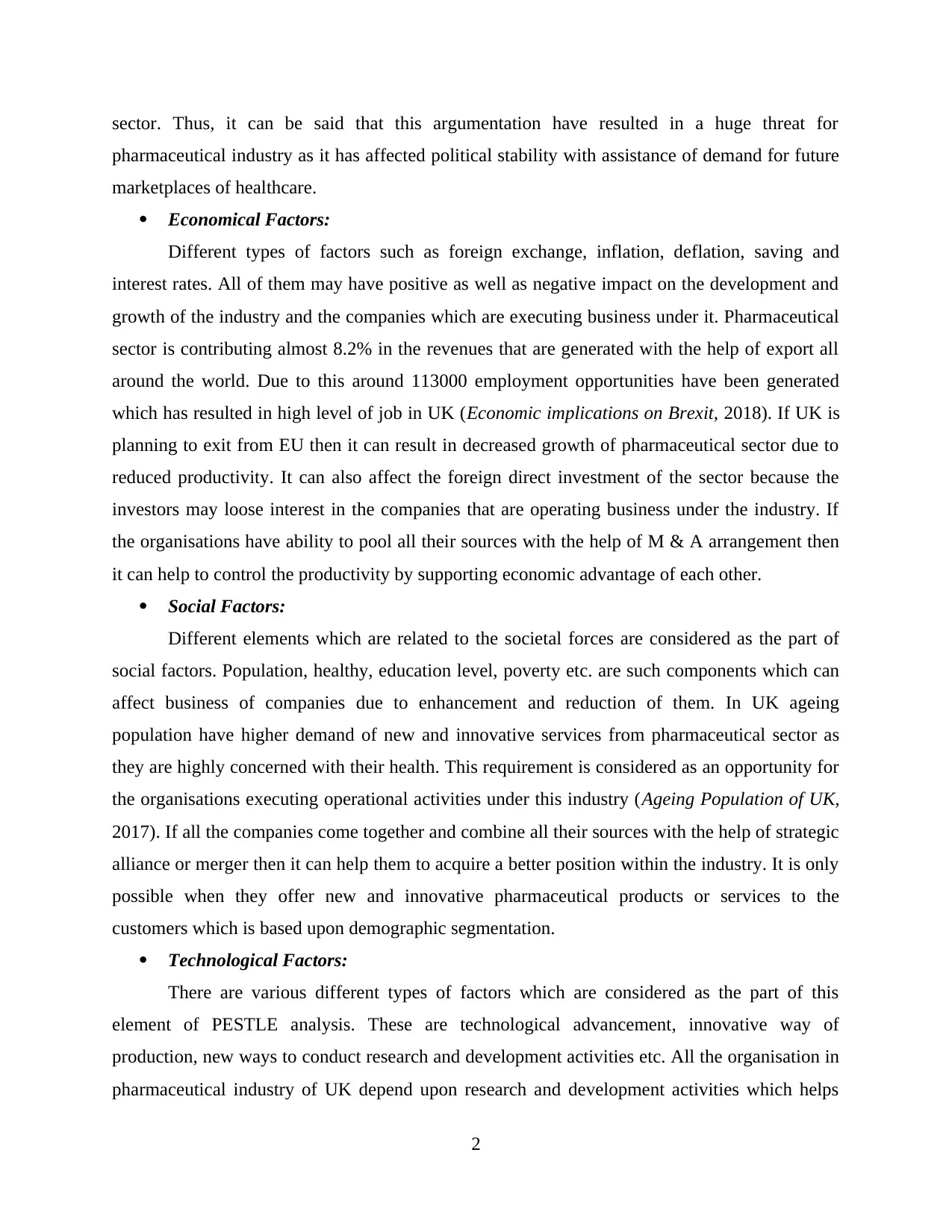
sector. Thus, it can be said that this argumentation have resulted in a huge threat for
pharmaceutical industry as it has affected political stability with assistance of demand for future
marketplaces of healthcare.
Economical Factors:
Different types of factors such as foreign exchange, inflation, deflation, saving and
interest rates. All of them may have positive as well as negative impact on the development and
growth of the industry and the companies which are executing business under it. Pharmaceutical
sector is contributing almost 8.2% in the revenues that are generated with the help of export all
around the world. Due to this around 113000 employment opportunities have been generated
which has resulted in high level of job in UK (Economic implications on Brexit, 2018). If UK is
planning to exit from EU then it can result in decreased growth of pharmaceutical sector due to
reduced productivity. It can also affect the foreign direct investment of the sector because the
investors may loose interest in the companies that are operating business under the industry. If
the organisations have ability to pool all their sources with the help of M & A arrangement then
it can help to control the productivity by supporting economic advantage of each other.
Social Factors:
Different elements which are related to the societal forces are considered as the part of
social factors. Population, healthy, education level, poverty etc. are such components which can
affect business of companies due to enhancement and reduction of them. In UK ageing
population have higher demand of new and innovative services from pharmaceutical sector as
they are highly concerned with their health. This requirement is considered as an opportunity for
the organisations executing operational activities under this industry (Ageing Population of UK,
2017). If all the companies come together and combine all their sources with the help of strategic
alliance or merger then it can help them to acquire a better position within the industry. It is only
possible when they offer new and innovative pharmaceutical products or services to the
customers which is based upon demographic segmentation.
Technological Factors:
There are various different types of factors which are considered as the part of this
element of PESTLE analysis. These are technological advancement, innovative way of
production, new ways to conduct research and development activities etc. All the organisation in
pharmaceutical industry of UK depend upon research and development activities which helps
2
pharmaceutical industry as it has affected political stability with assistance of demand for future
marketplaces of healthcare.
Economical Factors:
Different types of factors such as foreign exchange, inflation, deflation, saving and
interest rates. All of them may have positive as well as negative impact on the development and
growth of the industry and the companies which are executing business under it. Pharmaceutical
sector is contributing almost 8.2% in the revenues that are generated with the help of export all
around the world. Due to this around 113000 employment opportunities have been generated
which has resulted in high level of job in UK (Economic implications on Brexit, 2018). If UK is
planning to exit from EU then it can result in decreased growth of pharmaceutical sector due to
reduced productivity. It can also affect the foreign direct investment of the sector because the
investors may loose interest in the companies that are operating business under the industry. If
the organisations have ability to pool all their sources with the help of M & A arrangement then
it can help to control the productivity by supporting economic advantage of each other.
Social Factors:
Different elements which are related to the societal forces are considered as the part of
social factors. Population, healthy, education level, poverty etc. are such components which can
affect business of companies due to enhancement and reduction of them. In UK ageing
population have higher demand of new and innovative services from pharmaceutical sector as
they are highly concerned with their health. This requirement is considered as an opportunity for
the organisations executing operational activities under this industry (Ageing Population of UK,
2017). If all the companies come together and combine all their sources with the help of strategic
alliance or merger then it can help them to acquire a better position within the industry. It is only
possible when they offer new and innovative pharmaceutical products or services to the
customers which is based upon demographic segmentation.
Technological Factors:
There are various different types of factors which are considered as the part of this
element of PESTLE analysis. These are technological advancement, innovative way of
production, new ways to conduct research and development activities etc. All the organisation in
pharmaceutical industry of UK depend upon research and development activities which helps
2
Paraphrase This Document
Need a fresh take? Get an instant paraphrase of this document with our AI Paraphraser

them to analyse new technologies that are taking place and market and required by clients. With
the help of it different companies in the sector try to improve their production of medicines and
drugs. Continuous enhancement of artificial intelligence have resulted in use of new techniques
is become massive as the enterprises are focusing in developing of such ways which can help to
create highly patient centric future (Future of Pharmaceutical Industry, 2017). It is creating
opportunity for the major players in the sector and motivating them to expand their business. If
two or more parties in the industry agree to combine their resources and execute business
together with the help of merger then it can help them to find innovative ways to make
improvement in medicines. It can also guide the organisations to develop different options for
future medical treatments.
Legal Factors:
While operating business in a specific country or executing all around the world different
it is vary important for the companies to comply with different rules and regulations which are
imposed by legal authorities. Different factors such as healthy and safety act. employment law,
discrimination act, antitrust and consumer protection laws are part of legislation imposed by
government. In UK such types of laws are very strict hence, it is vital for all the pharmaceutical
companies to comply with all of them. The economy of the region is dealing with uncertainty of
stability of governmental bodies which has resulted in the situation of that this sector will be able
to move freely or not in UK (Legal Impact, 2017). The instability in UK is possessing different
threats for whole sector to generate revenues without interference of legal authorities. If the
organisations which are operating business in industry decide for merger then it will be
beneficial for them to run business in EU and out side of it with the encouragement of free
movement of their products all around the world.
Environmental Factors:
Various factors such as environmental policies, climate and weather are part of this
component of PESTLE analysis. In order to execute business appropriately in UK all the
pharmaceutical companies are required to make sure that their operational activities are not
affecting the environment. It has been observed that production activities of different drugs and
medicines is resulting in high level of pharmaceutical pollution (Pharmaceutical Pollution,
2018). Due to this number of patients are also increasing which are affected by pollution.
Currently the awareness regarding this issue is continuously increasing so it is vital for the
3
the help of it different companies in the sector try to improve their production of medicines and
drugs. Continuous enhancement of artificial intelligence have resulted in use of new techniques
is become massive as the enterprises are focusing in developing of such ways which can help to
create highly patient centric future (Future of Pharmaceutical Industry, 2017). It is creating
opportunity for the major players in the sector and motivating them to expand their business. If
two or more parties in the industry agree to combine their resources and execute business
together with the help of merger then it can help them to find innovative ways to make
improvement in medicines. It can also guide the organisations to develop different options for
future medical treatments.
Legal Factors:
While operating business in a specific country or executing all around the world different
it is vary important for the companies to comply with different rules and regulations which are
imposed by legal authorities. Different factors such as healthy and safety act. employment law,
discrimination act, antitrust and consumer protection laws are part of legislation imposed by
government. In UK such types of laws are very strict hence, it is vital for all the pharmaceutical
companies to comply with all of them. The economy of the region is dealing with uncertainty of
stability of governmental bodies which has resulted in the situation of that this sector will be able
to move freely or not in UK (Legal Impact, 2017). The instability in UK is possessing different
threats for whole sector to generate revenues without interference of legal authorities. If the
organisations which are operating business in industry decide for merger then it will be
beneficial for them to run business in EU and out side of it with the encouragement of free
movement of their products all around the world.
Environmental Factors:
Various factors such as environmental policies, climate and weather are part of this
component of PESTLE analysis. In order to execute business appropriately in UK all the
pharmaceutical companies are required to make sure that their operational activities are not
affecting the environment. It has been observed that production activities of different drugs and
medicines is resulting in high level of pharmaceutical pollution (Pharmaceutical Pollution,
2018). Due to this number of patients are also increasing which are affected by pollution.
Currently the awareness regarding this issue is continuously increasing so it is vital for the
3
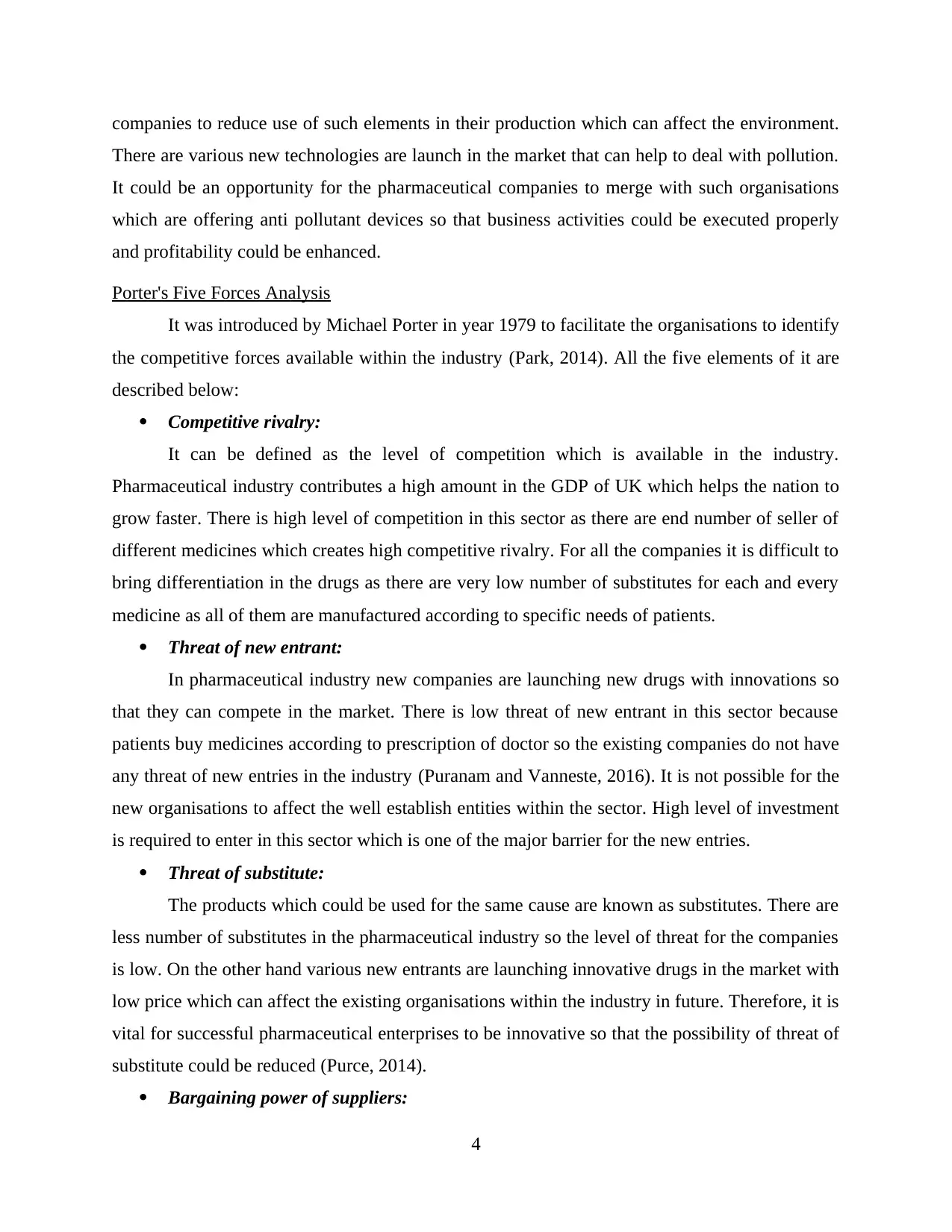
companies to reduce use of such elements in their production which can affect the environment.
There are various new technologies are launch in the market that can help to deal with pollution.
It could be an opportunity for the pharmaceutical companies to merge with such organisations
which are offering anti pollutant devices so that business activities could be executed properly
and profitability could be enhanced.
Porter's Five Forces Analysis
It was introduced by Michael Porter in year 1979 to facilitate the organisations to identify
the competitive forces available within the industry (Park, 2014). All the five elements of it are
described below:
Competitive rivalry:
It can be defined as the level of competition which is available in the industry.
Pharmaceutical industry contributes a high amount in the GDP of UK which helps the nation to
grow faster. There is high level of competition in this sector as there are end number of seller of
different medicines which creates high competitive rivalry. For all the companies it is difficult to
bring differentiation in the drugs as there are very low number of substitutes for each and every
medicine as all of them are manufactured according to specific needs of patients.
Threat of new entrant:
In pharmaceutical industry new companies are launching new drugs with innovations so
that they can compete in the market. There is low threat of new entrant in this sector because
patients buy medicines according to prescription of doctor so the existing companies do not have
any threat of new entries in the industry (Puranam and Vanneste, 2016). It is not possible for the
new organisations to affect the well establish entities within the sector. High level of investment
is required to enter in this sector which is one of the major barrier for the new entries.
Threat of substitute:
The products which could be used for the same cause are known as substitutes. There are
less number of substitutes in the pharmaceutical industry so the level of threat for the companies
is low. On the other hand various new entrants are launching innovative drugs in the market with
low price which can affect the existing organisations within the industry in future. Therefore, it is
vital for successful pharmaceutical enterprises to be innovative so that the possibility of threat of
substitute could be reduced (Purce, 2014).
Bargaining power of suppliers:
4
There are various new technologies are launch in the market that can help to deal with pollution.
It could be an opportunity for the pharmaceutical companies to merge with such organisations
which are offering anti pollutant devices so that business activities could be executed properly
and profitability could be enhanced.
Porter's Five Forces Analysis
It was introduced by Michael Porter in year 1979 to facilitate the organisations to identify
the competitive forces available within the industry (Park, 2014). All the five elements of it are
described below:
Competitive rivalry:
It can be defined as the level of competition which is available in the industry.
Pharmaceutical industry contributes a high amount in the GDP of UK which helps the nation to
grow faster. There is high level of competition in this sector as there are end number of seller of
different medicines which creates high competitive rivalry. For all the companies it is difficult to
bring differentiation in the drugs as there are very low number of substitutes for each and every
medicine as all of them are manufactured according to specific needs of patients.
Threat of new entrant:
In pharmaceutical industry new companies are launching new drugs with innovations so
that they can compete in the market. There is low threat of new entrant in this sector because
patients buy medicines according to prescription of doctor so the existing companies do not have
any threat of new entries in the industry (Puranam and Vanneste, 2016). It is not possible for the
new organisations to affect the well establish entities within the sector. High level of investment
is required to enter in this sector which is one of the major barrier for the new entries.
Threat of substitute:
The products which could be used for the same cause are known as substitutes. There are
less number of substitutes in the pharmaceutical industry so the level of threat for the companies
is low. On the other hand various new entrants are launching innovative drugs in the market with
low price which can affect the existing organisations within the industry in future. Therefore, it is
vital for successful pharmaceutical enterprises to be innovative so that the possibility of threat of
substitute could be reduced (Purce, 2014).
Bargaining power of suppliers:
4
⊘ This is a preview!⊘
Do you want full access?
Subscribe today to unlock all pages.

Trusted by 1+ million students worldwide
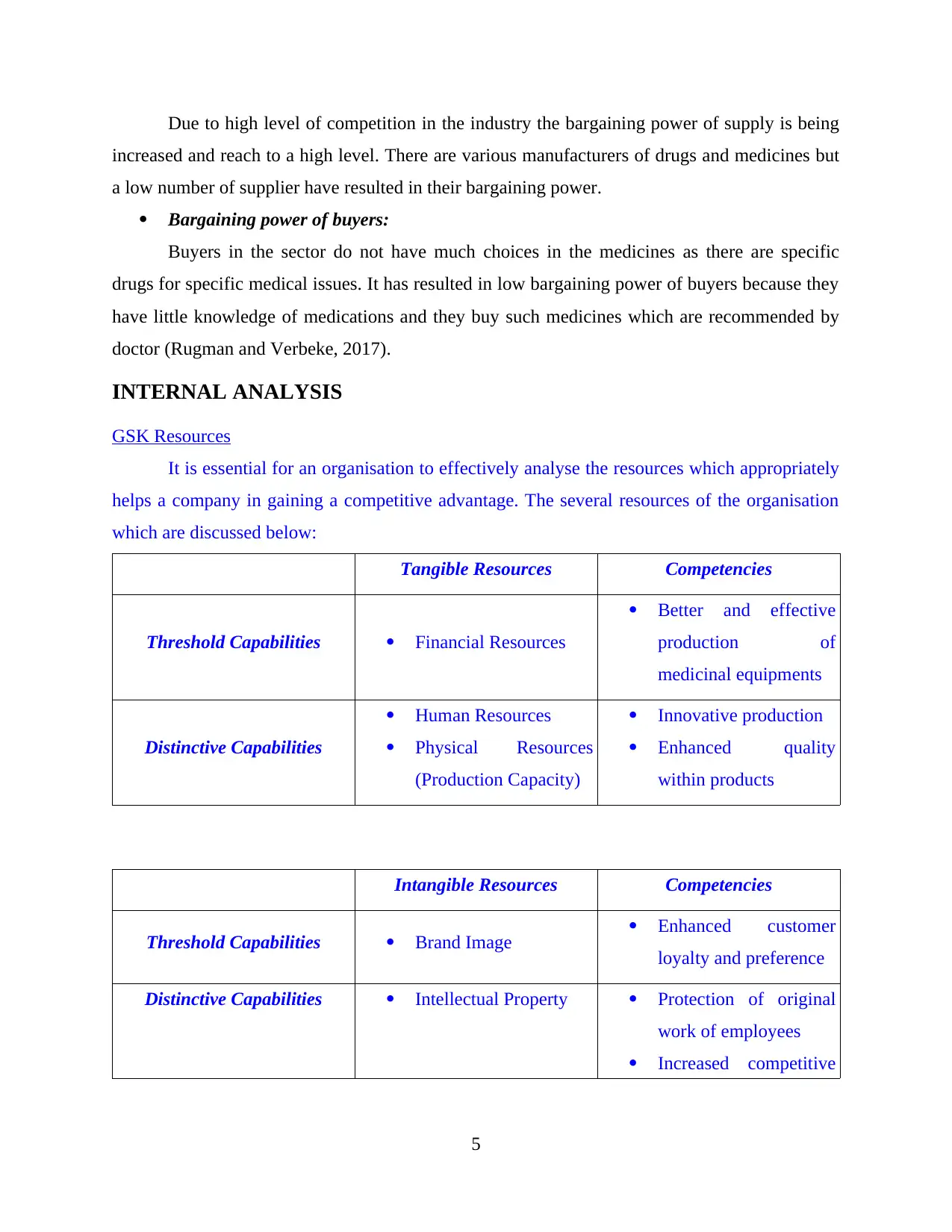
Due to high level of competition in the industry the bargaining power of supply is being
increased and reach to a high level. There are various manufacturers of drugs and medicines but
a low number of supplier have resulted in their bargaining power.
Bargaining power of buyers:
Buyers in the sector do not have much choices in the medicines as there are specific
drugs for specific medical issues. It has resulted in low bargaining power of buyers because they
have little knowledge of medications and they buy such medicines which are recommended by
doctor (Rugman and Verbeke, 2017).
INTERNAL ANALYSIS
GSK Resources
It is essential for an organisation to effectively analyse the resources which appropriately
helps a company in gaining a competitive advantage. The several resources of the organisation
which are discussed below:
Tangible Resources Competencies
Threshold Capabilities Financial Resources
Better and effective
production of
medicinal equipments
Distinctive Capabilities
Human Resources
Physical Resources
(Production Capacity)
Innovative production
Enhanced quality
within products
Intangible Resources Competencies
Threshold Capabilities Brand Image Enhanced customer
loyalty and preference
Distinctive Capabilities Intellectual Property Protection of original
work of employees
Increased competitive
5
increased and reach to a high level. There are various manufacturers of drugs and medicines but
a low number of supplier have resulted in their bargaining power.
Bargaining power of buyers:
Buyers in the sector do not have much choices in the medicines as there are specific
drugs for specific medical issues. It has resulted in low bargaining power of buyers because they
have little knowledge of medications and they buy such medicines which are recommended by
doctor (Rugman and Verbeke, 2017).
INTERNAL ANALYSIS
GSK Resources
It is essential for an organisation to effectively analyse the resources which appropriately
helps a company in gaining a competitive advantage. The several resources of the organisation
which are discussed below:
Tangible Resources Competencies
Threshold Capabilities Financial Resources
Better and effective
production of
medicinal equipments
Distinctive Capabilities
Human Resources
Physical Resources
(Production Capacity)
Innovative production
Enhanced quality
within products
Intangible Resources Competencies
Threshold Capabilities Brand Image Enhanced customer
loyalty and preference
Distinctive Capabilities Intellectual Property Protection of original
work of employees
Increased competitive
5
Paraphrase This Document
Need a fresh take? Get an instant paraphrase of this document with our AI Paraphraser
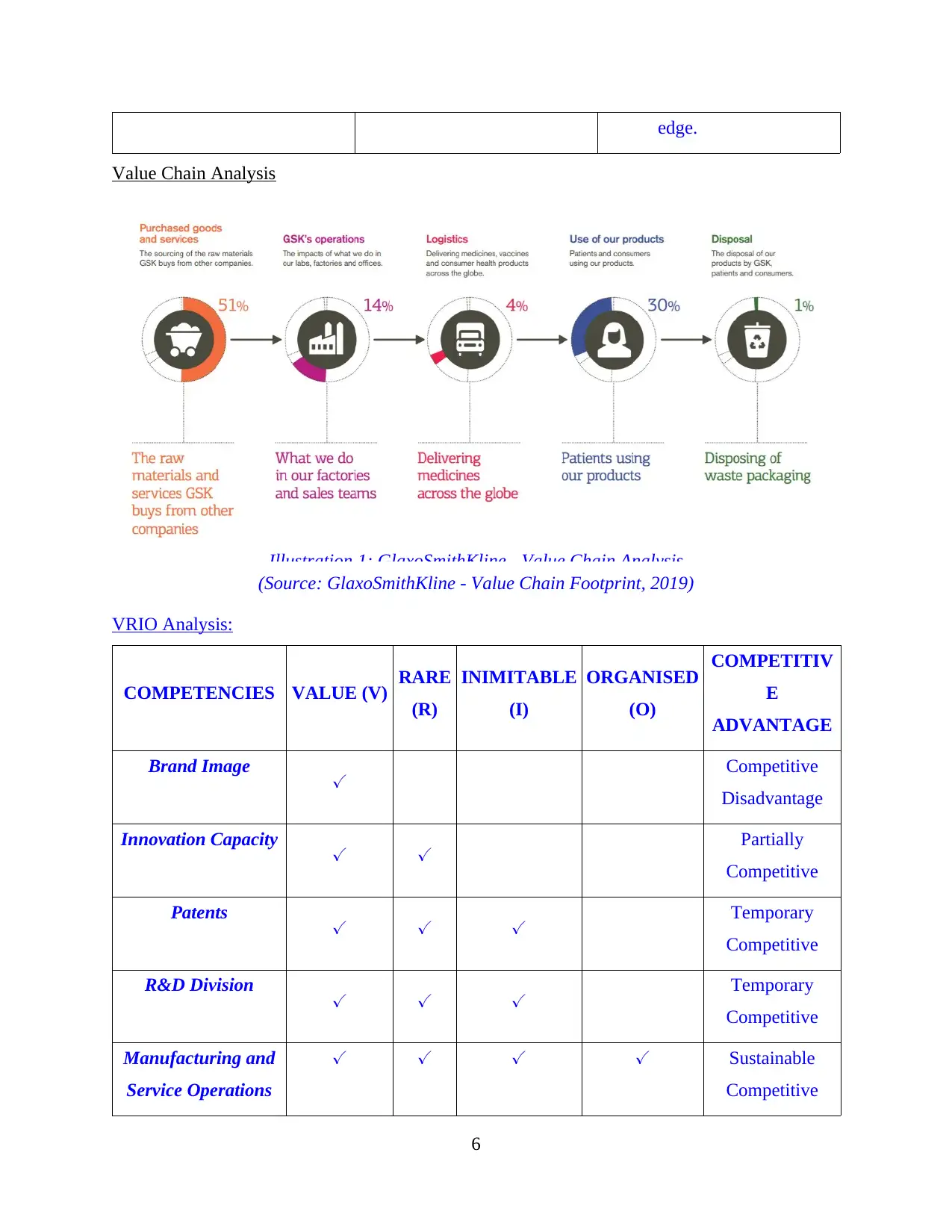
edge.
Value Chain Analysis
Illustration 1: GlaxoSmithKline - Value Chain Analysis
(Source: GlaxoSmithKline - Value Chain Footprint, 2019)
VRIO Analysis:
COMPETENCIES VALUE (V) RARE
(R)
INIMITABLE
(I)
ORGANISED
(O)
COMPETITIV
E
ADVANTAGE
Brand Image ✓ Competitive
Disadvantage
Innovation Capacity ✓ ✓ Partially
Competitive
Patents ✓ ✓ ✓ Temporary
Competitive
R&D Division ✓ ✓ ✓ Temporary
Competitive
Manufacturing and
Service Operations
✓ ✓ ✓ ✓ Sustainable
Competitive
6
Value Chain Analysis
Illustration 1: GlaxoSmithKline - Value Chain Analysis
(Source: GlaxoSmithKline - Value Chain Footprint, 2019)
VRIO Analysis:
COMPETENCIES VALUE (V) RARE
(R)
INIMITABLE
(I)
ORGANISED
(O)
COMPETITIV
E
ADVANTAGE
Brand Image ✓ Competitive
Disadvantage
Innovation Capacity ✓ ✓ Partially
Competitive
Patents ✓ ✓ ✓ Temporary
Competitive
R&D Division ✓ ✓ ✓ Temporary
Competitive
Manufacturing and
Service Operations
✓ ✓ ✓ ✓ Sustainable
Competitive
6
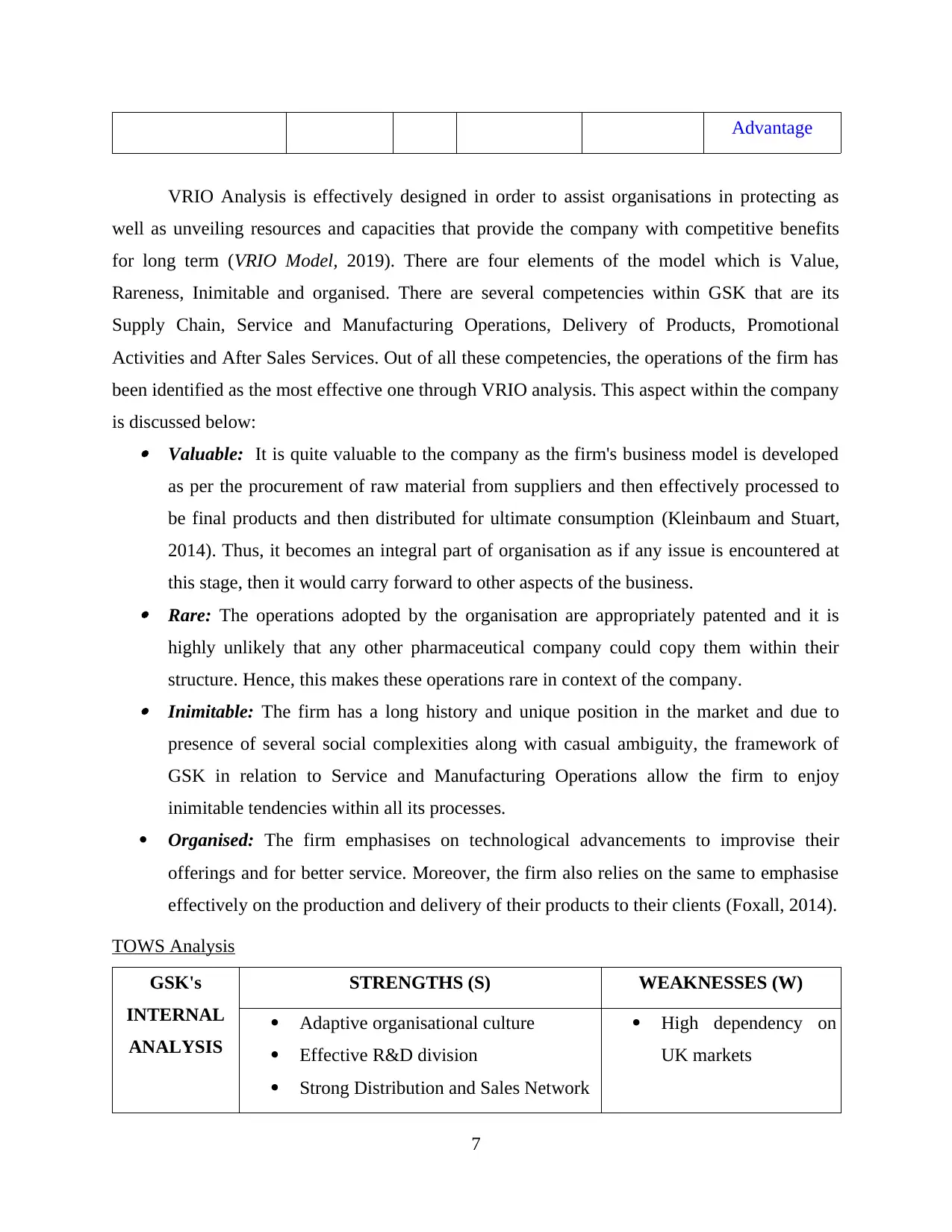
Advantage
VRIO Analysis is effectively designed in order to assist organisations in protecting as
well as unveiling resources and capacities that provide the company with competitive benefits
for long term (VRIO Model, 2019). There are four elements of the model which is Value,
Rareness, Inimitable and organised. There are several competencies within GSK that are its
Supply Chain, Service and Manufacturing Operations, Delivery of Products, Promotional
Activities and After Sales Services. Out of all these competencies, the operations of the firm has
been identified as the most effective one through VRIO analysis. This aspect within the company
is discussed below: Valuable: It is quite valuable to the company as the firm's business model is developed
as per the procurement of raw material from suppliers and then effectively processed to
be final products and then distributed for ultimate consumption (Kleinbaum and Stuart,
2014). Thus, it becomes an integral part of organisation as if any issue is encountered at
this stage, then it would carry forward to other aspects of the business. Rare: The operations adopted by the organisation are appropriately patented and it is
highly unlikely that any other pharmaceutical company could copy them within their
structure. Hence, this makes these operations rare in context of the company. Inimitable: The firm has a long history and unique position in the market and due to
presence of several social complexities along with casual ambiguity, the framework of
GSK in relation to Service and Manufacturing Operations allow the firm to enjoy
inimitable tendencies within all its processes.
Organised: The firm emphasises on technological advancements to improvise their
offerings and for better service. Moreover, the firm also relies on the same to emphasise
effectively on the production and delivery of their products to their clients (Foxall, 2014).
TOWS Analysis
GSK's
INTERNAL
ANALYSIS
STRENGTHS (S) WEAKNESSES (W)
Adaptive organisational culture
Effective R&D division
Strong Distribution and Sales Network
High dependency on
UK markets
7
VRIO Analysis is effectively designed in order to assist organisations in protecting as
well as unveiling resources and capacities that provide the company with competitive benefits
for long term (VRIO Model, 2019). There are four elements of the model which is Value,
Rareness, Inimitable and organised. There are several competencies within GSK that are its
Supply Chain, Service and Manufacturing Operations, Delivery of Products, Promotional
Activities and After Sales Services. Out of all these competencies, the operations of the firm has
been identified as the most effective one through VRIO analysis. This aspect within the company
is discussed below: Valuable: It is quite valuable to the company as the firm's business model is developed
as per the procurement of raw material from suppliers and then effectively processed to
be final products and then distributed for ultimate consumption (Kleinbaum and Stuart,
2014). Thus, it becomes an integral part of organisation as if any issue is encountered at
this stage, then it would carry forward to other aspects of the business. Rare: The operations adopted by the organisation are appropriately patented and it is
highly unlikely that any other pharmaceutical company could copy them within their
structure. Hence, this makes these operations rare in context of the company. Inimitable: The firm has a long history and unique position in the market and due to
presence of several social complexities along with casual ambiguity, the framework of
GSK in relation to Service and Manufacturing Operations allow the firm to enjoy
inimitable tendencies within all its processes.
Organised: The firm emphasises on technological advancements to improvise their
offerings and for better service. Moreover, the firm also relies on the same to emphasise
effectively on the production and delivery of their products to their clients (Foxall, 2014).
TOWS Analysis
GSK's
INTERNAL
ANALYSIS
STRENGTHS (S) WEAKNESSES (W)
Adaptive organisational culture
Effective R&D division
Strong Distribution and Sales Network
High dependency on
UK markets
7
⊘ This is a preview!⊘
Do you want full access?
Subscribe today to unlock all pages.

Trusted by 1+ million students worldwide
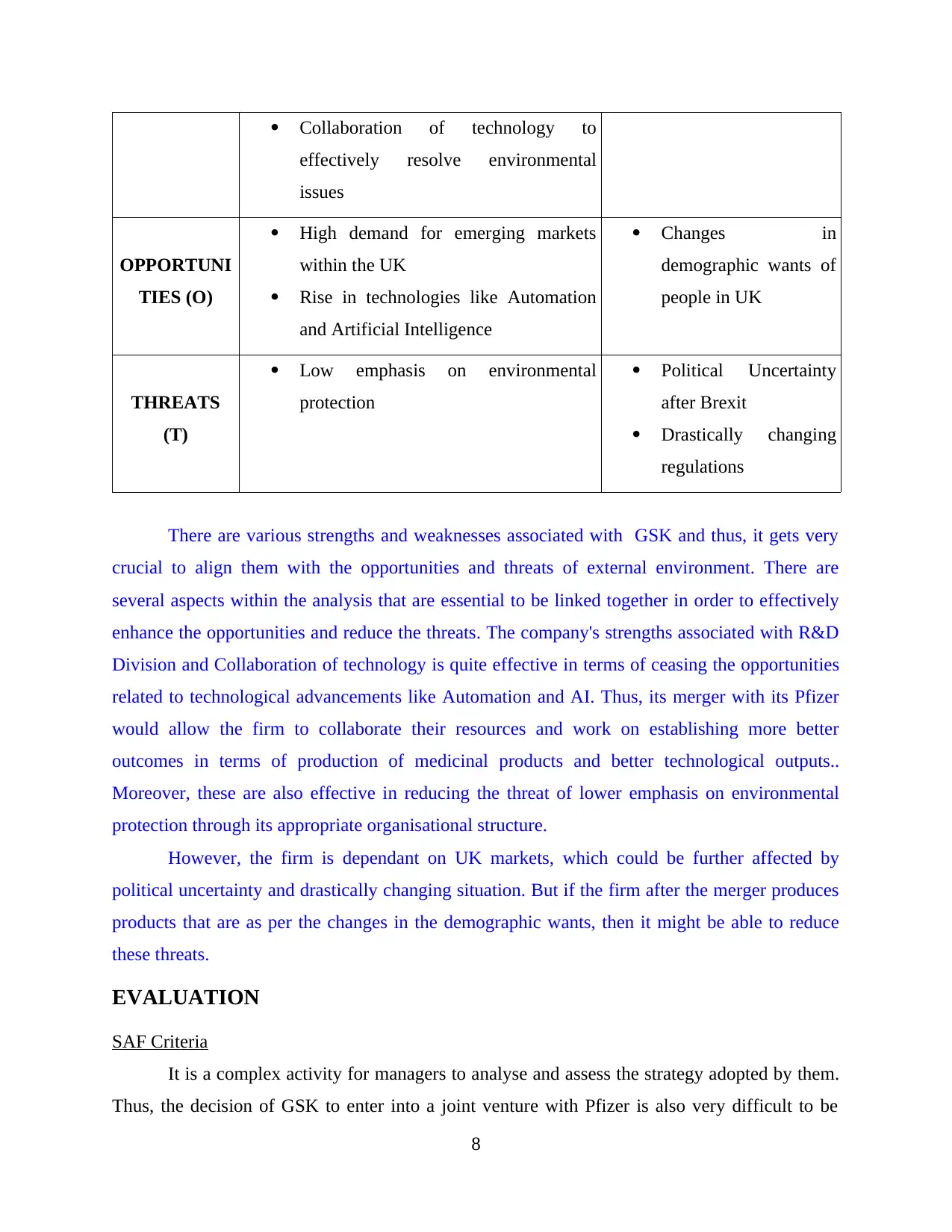
Collaboration of technology to
effectively resolve environmental
issues
OPPORTUNI
TIES (O)
High demand for emerging markets
within the UK
Rise in technologies like Automation
and Artificial Intelligence
Changes in
demographic wants of
people in UK
THREATS
(T)
Low emphasis on environmental
protection
Political Uncertainty
after Brexit
Drastically changing
regulations
There are various strengths and weaknesses associated with GSK and thus, it gets very
crucial to align them with the opportunities and threats of external environment. There are
several aspects within the analysis that are essential to be linked together in order to effectively
enhance the opportunities and reduce the threats. The company's strengths associated with R&D
Division and Collaboration of technology is quite effective in terms of ceasing the opportunities
related to technological advancements like Automation and AI. Thus, its merger with its Pfizer
would allow the firm to collaborate their resources and work on establishing more better
outcomes in terms of production of medicinal products and better technological outputs..
Moreover, these are also effective in reducing the threat of lower emphasis on environmental
protection through its appropriate organisational structure.
However, the firm is dependant on UK markets, which could be further affected by
political uncertainty and drastically changing situation. But if the firm after the merger produces
products that are as per the changes in the demographic wants, then it might be able to reduce
these threats.
EVALUATION
SAF Criteria
It is a complex activity for managers to analyse and assess the strategy adopted by them.
Thus, the decision of GSK to enter into a joint venture with Pfizer is also very difficult to be
8
effectively resolve environmental
issues
OPPORTUNI
TIES (O)
High demand for emerging markets
within the UK
Rise in technologies like Automation
and Artificial Intelligence
Changes in
demographic wants of
people in UK
THREATS
(T)
Low emphasis on environmental
protection
Political Uncertainty
after Brexit
Drastically changing
regulations
There are various strengths and weaknesses associated with GSK and thus, it gets very
crucial to align them with the opportunities and threats of external environment. There are
several aspects within the analysis that are essential to be linked together in order to effectively
enhance the opportunities and reduce the threats. The company's strengths associated with R&D
Division and Collaboration of technology is quite effective in terms of ceasing the opportunities
related to technological advancements like Automation and AI. Thus, its merger with its Pfizer
would allow the firm to collaborate their resources and work on establishing more better
outcomes in terms of production of medicinal products and better technological outputs..
Moreover, these are also effective in reducing the threat of lower emphasis on environmental
protection through its appropriate organisational structure.
However, the firm is dependant on UK markets, which could be further affected by
political uncertainty and drastically changing situation. But if the firm after the merger produces
products that are as per the changes in the demographic wants, then it might be able to reduce
these threats.
EVALUATION
SAF Criteria
It is a complex activity for managers to analyse and assess the strategy adopted by them.
Thus, the decision of GSK to enter into a joint venture with Pfizer is also very difficult to be
8
Paraphrase This Document
Need a fresh take? Get an instant paraphrase of this document with our AI Paraphraser
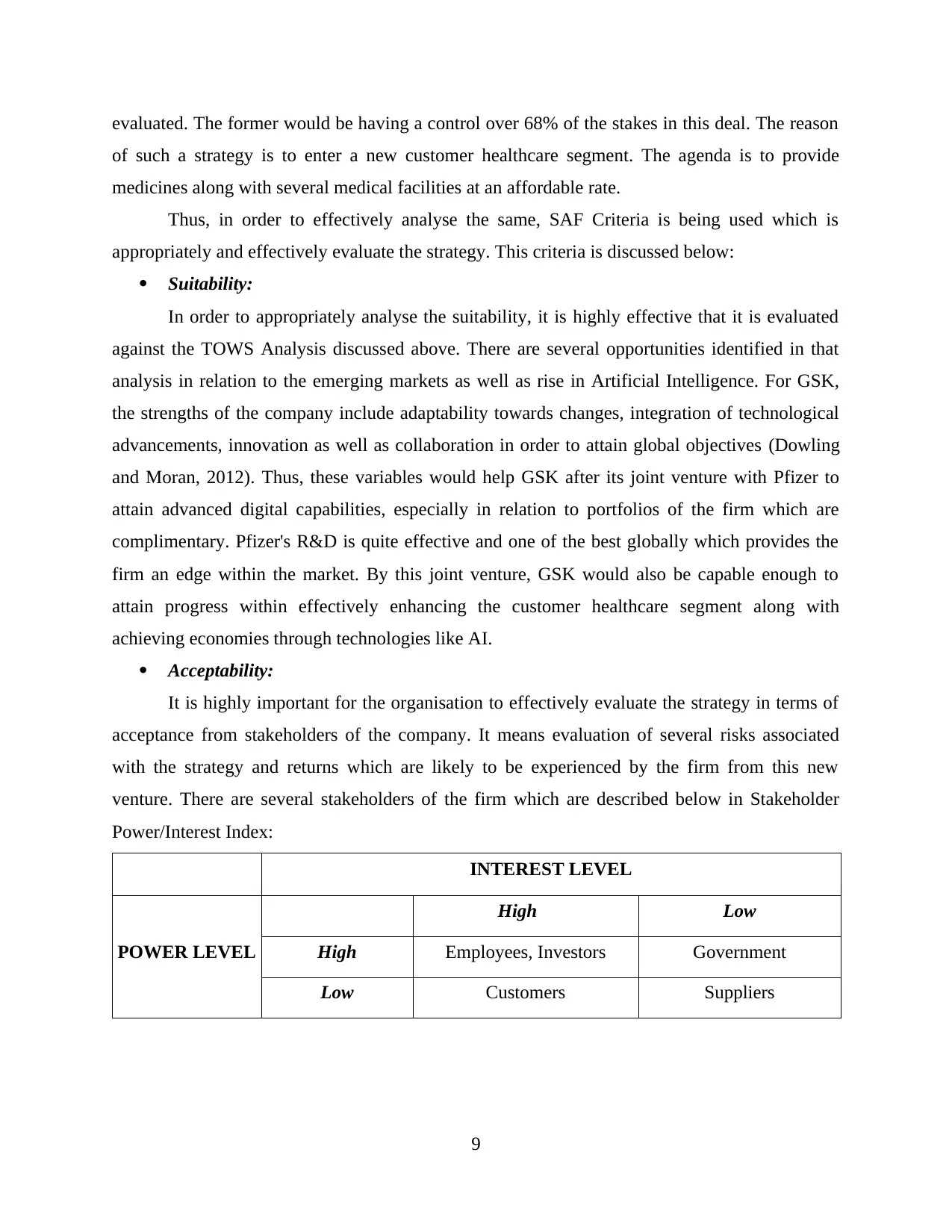
evaluated. The former would be having a control over 68% of the stakes in this deal. The reason
of such a strategy is to enter a new customer healthcare segment. The agenda is to provide
medicines along with several medical facilities at an affordable rate.
Thus, in order to effectively analyse the same, SAF Criteria is being used which is
appropriately and effectively evaluate the strategy. This criteria is discussed below:
Suitability:
In order to appropriately analyse the suitability, it is highly effective that it is evaluated
against the TOWS Analysis discussed above. There are several opportunities identified in that
analysis in relation to the emerging markets as well as rise in Artificial Intelligence. For GSK,
the strengths of the company include adaptability towards changes, integration of technological
advancements, innovation as well as collaboration in order to attain global objectives (Dowling
and Moran, 2012). Thus, these variables would help GSK after its joint venture with Pfizer to
attain advanced digital capabilities, especially in relation to portfolios of the firm which are
complimentary. Pfizer's R&D is quite effective and one of the best globally which provides the
firm an edge within the market. By this joint venture, GSK would also be capable enough to
attain progress within effectively enhancing the customer healthcare segment along with
achieving economies through technologies like AI.
Acceptability:
It is highly important for the organisation to effectively evaluate the strategy in terms of
acceptance from stakeholders of the company. It means evaluation of several risks associated
with the strategy and returns which are likely to be experienced by the firm from this new
venture. There are several stakeholders of the firm which are described below in Stakeholder
Power/Interest Index:
INTEREST LEVEL
POWER LEVEL
High Low
High Employees, Investors Government
Low Customers Suppliers
9
of such a strategy is to enter a new customer healthcare segment. The agenda is to provide
medicines along with several medical facilities at an affordable rate.
Thus, in order to effectively analyse the same, SAF Criteria is being used which is
appropriately and effectively evaluate the strategy. This criteria is discussed below:
Suitability:
In order to appropriately analyse the suitability, it is highly effective that it is evaluated
against the TOWS Analysis discussed above. There are several opportunities identified in that
analysis in relation to the emerging markets as well as rise in Artificial Intelligence. For GSK,
the strengths of the company include adaptability towards changes, integration of technological
advancements, innovation as well as collaboration in order to attain global objectives (Dowling
and Moran, 2012). Thus, these variables would help GSK after its joint venture with Pfizer to
attain advanced digital capabilities, especially in relation to portfolios of the firm which are
complimentary. Pfizer's R&D is quite effective and one of the best globally which provides the
firm an edge within the market. By this joint venture, GSK would also be capable enough to
attain progress within effectively enhancing the customer healthcare segment along with
achieving economies through technologies like AI.
Acceptability:
It is highly important for the organisation to effectively evaluate the strategy in terms of
acceptance from stakeholders of the company. It means evaluation of several risks associated
with the strategy and returns which are likely to be experienced by the firm from this new
venture. There are several stakeholders of the firm which are described below in Stakeholder
Power/Interest Index:
INTEREST LEVEL
POWER LEVEL
High Low
High Employees, Investors Government
Low Customers Suppliers
9
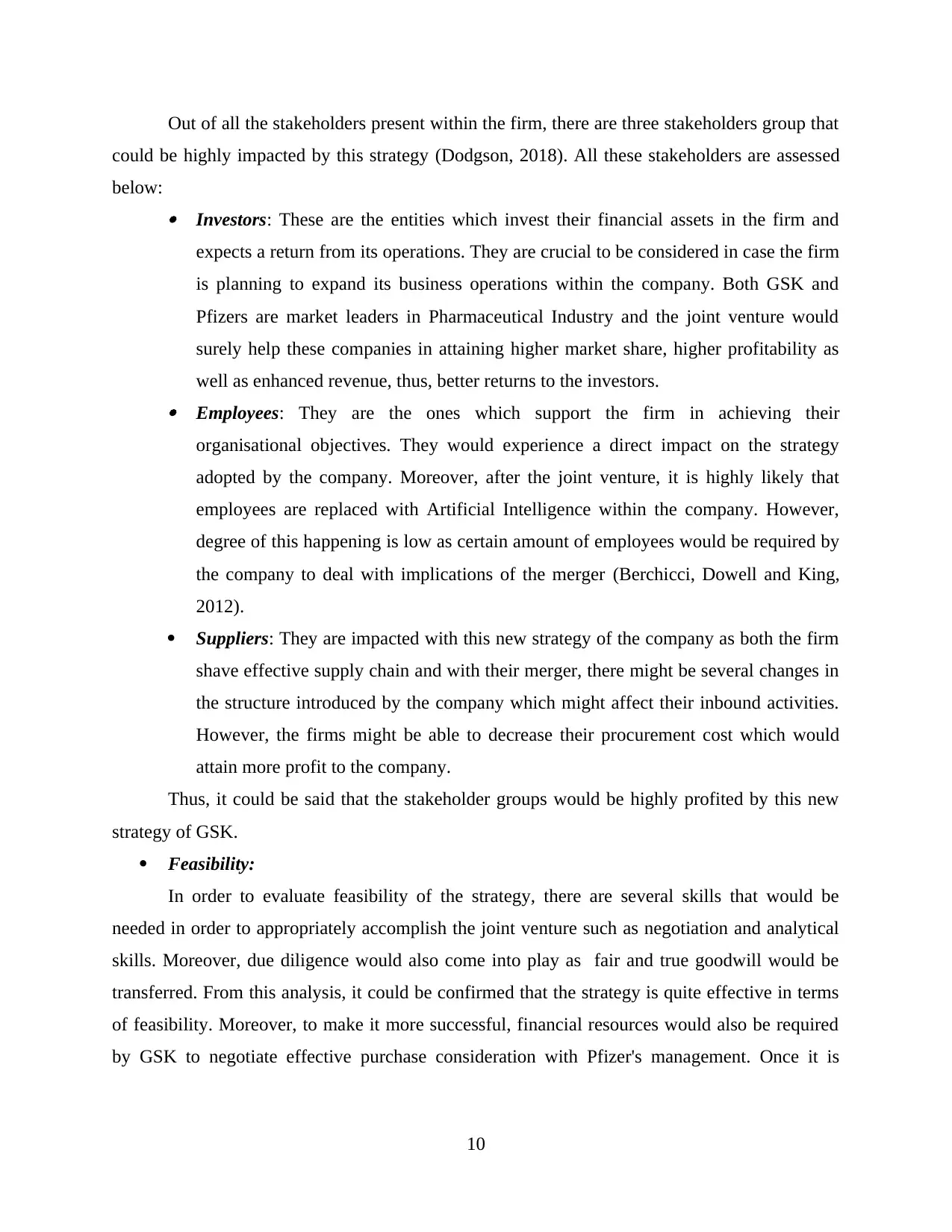
Out of all the stakeholders present within the firm, there are three stakeholders group that
could be highly impacted by this strategy (Dodgson, 2018). All these stakeholders are assessed
below: Investors: These are the entities which invest their financial assets in the firm and
expects a return from its operations. They are crucial to be considered in case the firm
is planning to expand its business operations within the company. Both GSK and
Pfizers are market leaders in Pharmaceutical Industry and the joint venture would
surely help these companies in attaining higher market share, higher profitability as
well as enhanced revenue, thus, better returns to the investors.
Employees: They are the ones which support the firm in achieving their
organisational objectives. They would experience a direct impact on the strategy
adopted by the company. Moreover, after the joint venture, it is highly likely that
employees are replaced with Artificial Intelligence within the company. However,
degree of this happening is low as certain amount of employees would be required by
the company to deal with implications of the merger (Berchicci, Dowell and King,
2012).
Suppliers: They are impacted with this new strategy of the company as both the firm
shave effective supply chain and with their merger, there might be several changes in
the structure introduced by the company which might affect their inbound activities.
However, the firms might be able to decrease their procurement cost which would
attain more profit to the company.
Thus, it could be said that the stakeholder groups would be highly profited by this new
strategy of GSK.
Feasibility:
In order to evaluate feasibility of the strategy, there are several skills that would be
needed in order to appropriately accomplish the joint venture such as negotiation and analytical
skills. Moreover, due diligence would also come into play as fair and true goodwill would be
transferred. From this analysis, it could be confirmed that the strategy is quite effective in terms
of feasibility. Moreover, to make it more successful, financial resources would also be required
by GSK to negotiate effective purchase consideration with Pfizer's management. Once it is
10
could be highly impacted by this strategy (Dodgson, 2018). All these stakeholders are assessed
below: Investors: These are the entities which invest their financial assets in the firm and
expects a return from its operations. They are crucial to be considered in case the firm
is planning to expand its business operations within the company. Both GSK and
Pfizers are market leaders in Pharmaceutical Industry and the joint venture would
surely help these companies in attaining higher market share, higher profitability as
well as enhanced revenue, thus, better returns to the investors.
Employees: They are the ones which support the firm in achieving their
organisational objectives. They would experience a direct impact on the strategy
adopted by the company. Moreover, after the joint venture, it is highly likely that
employees are replaced with Artificial Intelligence within the company. However,
degree of this happening is low as certain amount of employees would be required by
the company to deal with implications of the merger (Berchicci, Dowell and King,
2012).
Suppliers: They are impacted with this new strategy of the company as both the firm
shave effective supply chain and with their merger, there might be several changes in
the structure introduced by the company which might affect their inbound activities.
However, the firms might be able to decrease their procurement cost which would
attain more profit to the company.
Thus, it could be said that the stakeholder groups would be highly profited by this new
strategy of GSK.
Feasibility:
In order to evaluate feasibility of the strategy, there are several skills that would be
needed in order to appropriately accomplish the joint venture such as negotiation and analytical
skills. Moreover, due diligence would also come into play as fair and true goodwill would be
transferred. From this analysis, it could be confirmed that the strategy is quite effective in terms
of feasibility. Moreover, to make it more successful, financial resources would also be required
by GSK to negotiate effective purchase consideration with Pfizer's management. Once it is
10
⊘ This is a preview!⊘
Do you want full access?
Subscribe today to unlock all pages.

Trusted by 1+ million students worldwide
1 out of 15
Related Documents
Your All-in-One AI-Powered Toolkit for Academic Success.
+13062052269
info@desklib.com
Available 24*7 on WhatsApp / Email
![[object Object]](/_next/static/media/star-bottom.7253800d.svg)
Unlock your academic potential
Copyright © 2020–2025 A2Z Services. All Rights Reserved. Developed and managed by ZUCOL.




